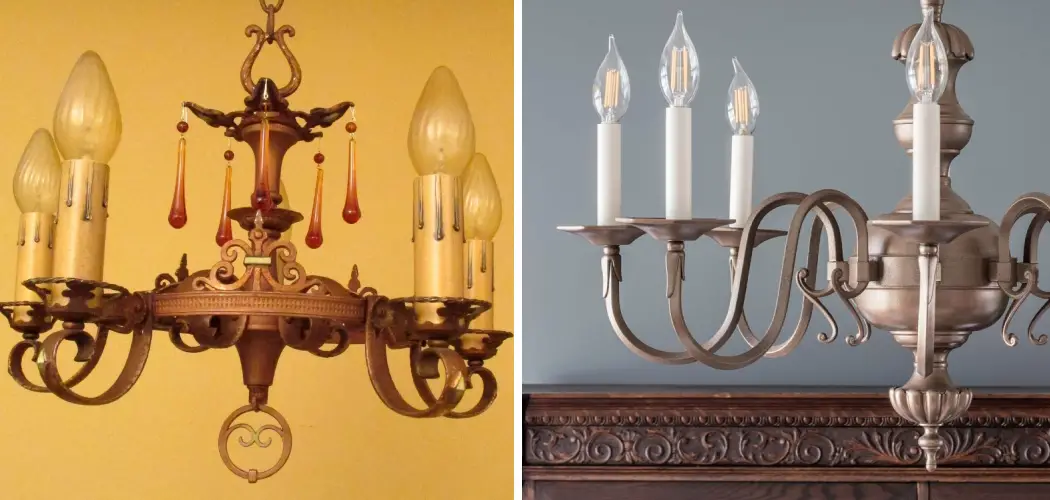Do you have a dull and outdated chandelier in your home that could use an upgrade? Are you intimidated by the thought of painting a chandelier? Have you been dreaming of revamping your current fixture but don’t know where to start?

Painting is the perfect way to dress up any room and add a unique touch of design. With just a few simple tools, some time, and creativity, you can transform even the most dated chandelier into one with an updated style.
In this blog post, we’ll give you step-by-step instructions on how to paint a chandelier, from basic cleaning and prepping all the way through applying new paint or finishing touches for maximum aesthetic appeal. No more living with an unattractive light fixture – learn how to bring vibrancy back to its lights!
Why Do You Need to Paint a Chandelier?
1. Add Style
Painting your chandelier is the perfect way to update and upgrade its look. By taking the time to give your existing fixture a new look, you can save money that would have gone towards buying a brand-new one. In addition, customizing it with paint gives you an opportunity to add your own personal touch and style, creating a unique piece that would have otherwise been impossible to find.
2. Cover Imperfections
If your chandelier has scratches, rust, or other imperfections that you don’t want to be seen, painting it is an excellent way to cover them up and create a smooth surface for light to reflect off of. By taking the time to completely refinish it, you can create a beautiful, polished look that will bring any room together.
Things to Consider While Painting a Chandelier
1. Matching Paint Colors
When you’re ready to start painting, it’s important that you make sure the paint colors match your existing décor. The best way to do this is by taking a picture of the room with you when you visit the hardware store and matching them up with options available there. You can also try experimenting with different colors and shades to find something that really pops.
2. Size of the Room
The size of the room is another important factor to consider when painting a chandelier. If it’s too big, it will overpower the space and can be visually overwhelming; if it’s too small, it won’t be able to provide enough light. Take measurements of both the chandelier and the room to determine what size would be best suited for the space.

3. Safety
Never attempt to paint a chandelier while it’s still hanging, and make sure you turn off the power at the source first. If you don’t feel comfortable taking on this task alone, it’s best to call in a professional to ensure the electricity is disconnected and all safety precautions are met.
How To Prepare Your Chandelier for Painting
1. Clean the Fixture
The first step in painting a chandelier is to make sure it’s clean of dust and dirt. Use an all-purpose cleaner and a soft cloth to wipe down all of the parts of the chandelier, taking special care not to scratch or damage any finishes.
2. Remove All Electrical Components
Once your fixture is clean, it’s time to remove all of its electrical components, such as bulbs, sockets, and wiring. This is an important step to ensure that no electrical current flows through the chandelier while you’re working on it.
3. Sand and Prime
Once all of its parts are removed, use sandpaper to lightly scuff up the surface of the metal or wood so that paint can adhere properly. After sanding, apply a coat of primer to prepare the surface for painting.
Choosing the Best Paint for Chandelier
Once you’ve finished prepping your chandelier, it’s time to pick out the best paint for the job. There are several types of paints available on the market that work well on light fixtures, such as spray paint, chalk paint, and acrylic paint.

Spray paint is generally the easiest to use and provides a smooth, even finish. Chalk paint can also be used, but it is best for creating a textured look. If you’re looking for a glossy finish, then acrylic paints are your best bet.
Required Items for Painting a Chandelier
- Paint
- Primer
- Sandpaper or steel wool
- Drop cloths
- Painter’s tape
- All-purpose cleaner and soft cloths
Painting your chandelier can be an intimidating task, but with the right supplies and knowledge on how to paint a chandelier, you can completely transform an outdated fixture with ease. With this guide in hand, you’ll have all the tools necessary to make your chandelier shine and add a unique touch of style to any room. Have fun painting, and don’t forget to show off your new creation!
10 Instructions on How to Paint a Chandelier
1. Turn Off the Power
Turn off the power at the source and remove all electrical components from the chandelier. It is needed to ensure the electricity is disconnected and all safety precautions are met. Remember to never attempt to paint a chandelier while it’s still hanging.
2. Clean the Fixture
Use an all-purpose cleaner and a soft cloth to wipe down all of the parts of the chandelier, taking special care not to scratch or damage any finishes. Make sure it is clean of dust and dirt before beginning the painting process.

3. Sand and Prime
Use sandpaper to lightly scuff up the surface of the metal or wood so that paint can adhere properly. After sanding, apply a coat of primer to prepare the surface for painting. Sanding is the most important step in prepping a chandelier for painting.
4. Choose the Right Paint
Spray paint is generally the easiest to use and provides a smooth, even finish. However, you can also try experimenting with different colors and shades of chalk paint or acrylic paints to find something that really pops. Make sure the paint matches your existing décor.
5. Paint the Fixture
Once you’ve chosen the best paint for your chandelier, start by painting each piece separately. Begin with one of the arms or a cluster of crystals and work your way around in order to achieve an even finish. Apply multiple light coats of paint until desired coverage is achieved.
6. Allow the Paint to Dry
Allow the paint to completely cure and dry before moving on to the next step. The length of time will depend on the type of paint you’re using, so make sure you check the manufacturer’s instructions for drying times.
7. Add Additional Coats of Paint
If desired, you can apply additional coats of paint for a thicker finish. Make sure to sand lightly between each coat and take special care not to scratch or damage any finishes. Additional coats will provide additional protection against wear and tear.
8. Reassemble the Chandelier
Once everything is dry, it’s time to put your chandelier back together. Start with the arms or clusters of crystals and then add the remaining pieces accordingly. Make sure all electrical components are correctly installed before turning on the power.

9. Hang the Fixture
Follow the manufacturer’s instructions for hanging the chandelier, or consider calling in a professional if you don’t feel comfortable doing this yourself. Make sure all safety precautions are followed and that there is no electrical current running through the fixture before you hang it back up.
10. Enjoy your Newly Painted Chandelier
Once the chandelier is hung, it’s time to step back and admire your work. A freshly painted light fixture can completely transform any room or space, adding a unique touch of style and much-needed illumination. Be proud of what you have accomplished!
By following these steps on how to paint a chandelier, you’ll be able to successfully paint a chandelier in no time. With the right supplies and knowledge, you can easily give an outdated fixture a new look and create something that is truly unique. So don’t be afraid to take on this task; with your newfound skills, you just might start up your own lighting design business!
8 Maintenance Tips for Painted Chandelier
1. Clean the chandelier before painting to remove any dust or dirt that has accumulated on it. Be sure to use a lint-free cloth when cleaning and avoid using any harsh chemicals, as they can damage the finish of the chandelier.
2. Use painter’s tape to mask off areas that you don’t want to paint, such as electrical connections or glass pieces. This will help ensure that those parts stay clean and free of paint.
3. Keep the room well ventilated while painting. Open windows and use fans to keep the air circulating, as fumes from the paint can be hazardous.
4. Apply a primer to the chandelier before painting it with your chosen color. This will help ensure that the paint adheres better and is more likely to last longer than if you skip this step. It will also help ensure that the new paint matches the color of your chandelier.
5. Apply thin coats of paint to the chandelier in order to minimize any drips or runs that may occur. Allow plenty of time for each coat to dry before adding a second or third layer of paint.
6. When painting, use a brush or roller that is specifically designed to work on metal surfaces. This will help ensure that the paint adheres properly and won’t chip or flake off over time.
7. After painting, allow the chandelier to dry completely before reassembling it. If possible, hang it in a well-ventilated space away from direct sunlight and drafts to help it dry more quickly.
8. To help keep your painted chandelier looking its best, clean it periodically with a soft cloth and mild detergent to remove any dust or dirt that has accumulated on it. Avoid using abrasive cleaning products, as these can damage the paint finish.
Finally, be sure to inspect the chandelier regularly and make any necessary repairs in order to keep it looking its best. With proper care, your newly painted chandelier will last for years to come!

Conclusion
As you can see, painting a chandelier is a job that requires special skill and patience. You would be wise to research and plan before starting the project so that you don’t get overwhelmed. Additionally, choose a style of paint that fits your needs and room setup, as certain types will look different than others.
Finally, if you feel like you don’t have the skill or time to repaint your chandelier yourself, hiring professionals is always an option; they should know exactly how to transform it into your desired piece.
The steps of how to paint a chandelier are part of an art form that has moved through centuries and generations, from intricate candlelit chandeliers lighting salons in the Age of Enlightenment to beating modern light fixtures hanging in modern-day homes.
Whether it’s done for aesthetic reasons or because of a refurbishing necessity, understanding the task from beginning to end will help make sure the work is done safely and with beautiful results.
You Can Check It Out Hang Ceiling Fan and Chandelier in Same Room

